Stream流操作
# Stream初相识
概括讲,可以将Stream流操作分为3种类型:
- 创建Stream
- Stream中间处理
- 终止Steam
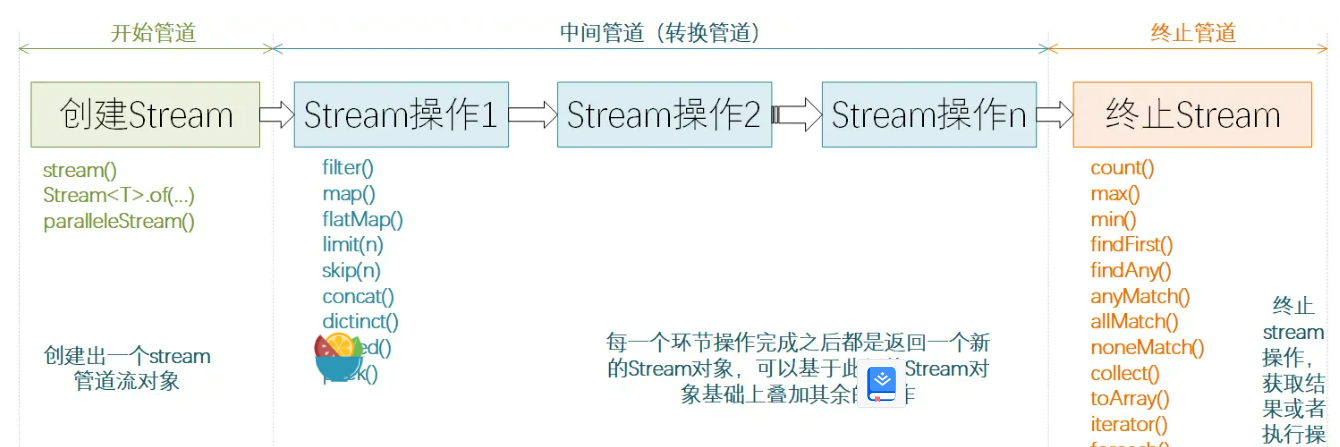
开始管道

中间管道
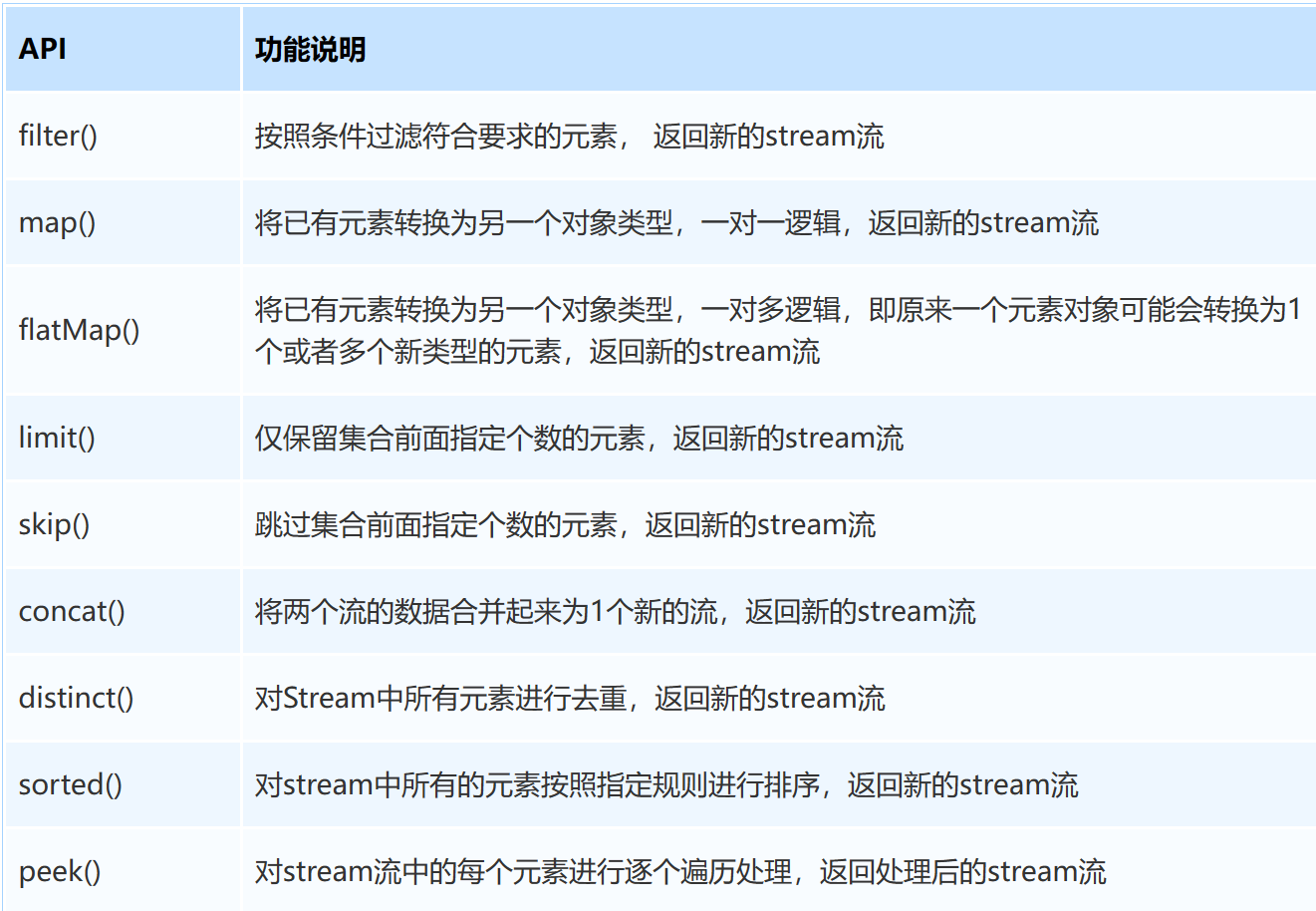
中间管道
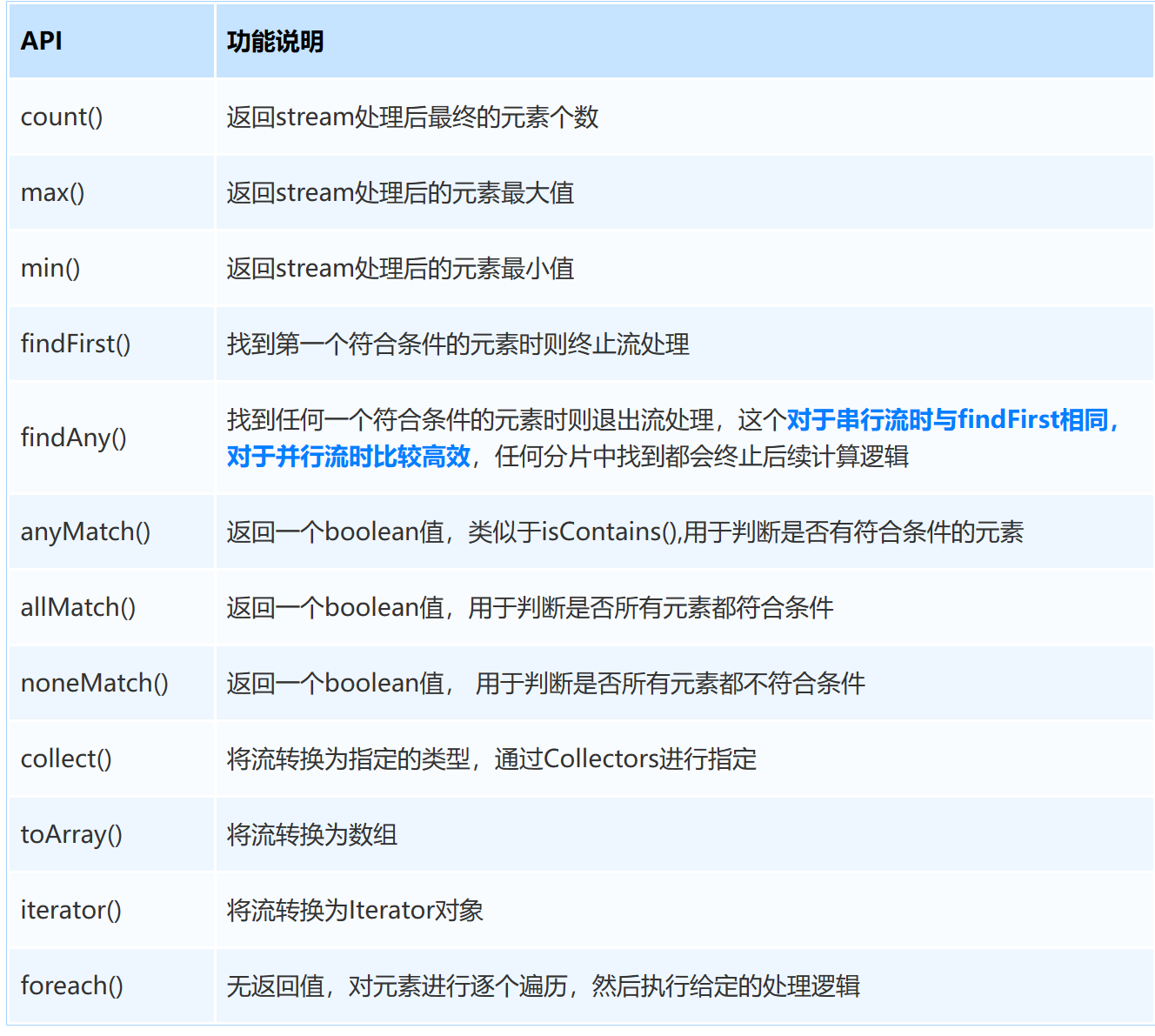
# Stream方法使用
# map与flatMap
map与flatMap都是用于转换已有的元素为其它元素,区别点在于:
- map 必须是一对一的,即每个元素都只能转换为1个新的元素
- flatMap 可以是一对多的,即每个元素都可以转换为1个或者多个新的元素
比如:有一个字符串ID列表,现在需要将其转为User对象列表。可以使用map来实现:
/**
* 演示map的用途:一对一转换
*/
public void stringToIntMap() {
List<String> ids = Arrays.asList("205", "105", "308", "469", "627", "193", "111");
// 使用流操作
List<User> results = ids.stream()
.map(id -> {
User user = new User();
user.setId(id);
return user;
})
.collect(Collectors.toList());
System.out.println(results);
}
[User{id='205'},
User{id='105'},
User{id='308'},
User{id='469'},
User{id='627'},
User{id='193'},
User{id='111'}]
现有一个句子列表,需要将句子中每个单词都提取出来得到一个所有单词列表。这种情况用map就搞不定了,需要flatMap上场了:
public void stringToIntFlatmap() {
List<String> sentences = Arrays.asList("hello world","Jia Gou Wu Dao");
// 使用流操作
List<String> results = sentences.stream()
.flatMap(sentence -> Arrays.stream(sentence.split(" ")))
.collect(Collectors.toList());
System.out.println(results);
}
[hello, world, Jia, Gou, Wu, Dao]
# peek和foreach方法
peek和foreach,都可以用于对元素进行遍历然后逐个的进行处理。 但根据前面的介绍,peek属于中间方法,而foreach属于终止方法。这也就意味着peek只能作为管道中途的一个处理步骤,而没法直接执行得到结果,其后面必须还要有其它终止操作的时候才会被执行;而foreach作为无返回值的终止方法,则可以直接执行相关操作。
public void testPeekAndforeach() {
List<String> sentences = Arrays.asList("hello world","Jia Gou Wu Dao");
// 演示点1: 仅peek操作,最终不会执行
System.out.println("----before peek----");
sentences.stream().peek(sentence -> System.out.println(sentence));
System.out.println("----after peek----");
// 演示点2: 仅foreach操作,最终会执行
System.out.println("----before foreach----");
sentences.stream().forEach(sentence -> System.out.println(sentence));
System.out.println("----after foreach----");
// 演示点3: peek操作后面增加终止操作,peek会执行
System.out.println("----before peek and count----");
sentences.stream().peek(sentence -> System.out.println(sentence)).count();
System.out.println("----after peek and count----");
}
输出结果可以看出,peek独自调用时并没有被执行、但peek后面加上终止操作之后便可以被执行,而foreach可以直接被执行:
----before peek----
----after peek----
----before foreach----
hello world
Jia Gou Wu Dao
----after foreach----
----before peek and count----
hello world
Jia Gou Wu Dao
----after peek and count----
# filter、sorted、distinct、limit
这几个都是常用的Stream的中间操作方法,具体的方法的含义在上面的表格里面有说明。具体使用的时候,可以根据需要选择一个或者多个进行组合使用,或者同时使用多个相同方法的组合:
public void testGetTargetUsers() {
List<String> ids = Arrays.asList("205","10","308","49","627","193","111", "193");
// 使用流操作
List<Dept> results = ids.stream()
.filter(s -> s.length() > 2)
.distinct()
.map(Integer::valueOf)
.sorted(Comparator.comparingInt(o -> o))
.limit(3)
.map(id -> new Dept(id))
.collect(Collectors.toList());
System.out.println(results);
}
上面的代码片段的处理逻辑很清晰:
- 使用filter过滤掉不符合条件的数据
- 通过distinct对存量元素进行去重操作
- 通过map操作将字符串转成整数类型
- 借助sorted指定按照数字大小正序排列
- 使用limit截取排在前3位的元素
- 又一次使用map将id转为Dept对象类型
- 使用collect终止操作将最终处理后的数据收集到list中
[Dept{id=111}, Dept{id=193}, Dept{id=205}]
# 简单结果终止方法
按照前面介绍的,终止方法里面像count、max、min、findAny、findFirst、anyMatch、allMatch、nonneMatch等方法,均属于这里说的简单结果终止方法。所谓简单,指的是其结果形式是数字、布尔值或者Optional对象值等。
public void testSimpleStopOptions() {
List<String> ids = Arrays.asList("205", "10", "308", "49", "627", "193", "111", "193");
// 统计stream操作后剩余的元素个数
System.out.println(ids.stream().filter(s -> s.length() > 2).count());
// 判断是否有元素值等于205
System.out.println(ids.stream().filter(s -> s.length() > 2).anyMatch("205"::equals));
// findFirst操作
ids.stream().filter(s -> s.length() > 2)
.findFirst()
.ifPresent(s -> System.out.println("findFirst:" + s));
}
6
true
findFirst:205
避坑提醒 这里需要补充提醒下,一旦一个Stream被执行了终止操作之后,后续便不可以再读这个流执行其他的操作了,否则会报错
# Collector
# collect\Collector\Collectors区别与关联
- collect是Stream流的一个终止方法,会使用传入的收集器(入参)对结果执行相关的操作,这个收集器必须是Collector接口的某个具体实现类
- Collector是一个接口,collect方法的收集器是Collector接口的具体实现类
- Collectors是一个工具类,提供了很多的静态工厂方法,提供了很多Collector接口的具体实现类,是为了方便程序员使用而预置的一些较为通用的收集器(如果不使用Collectors类,而是自己去实现Collector接口,也可以)。
# Collector使用与剖析
Stream结果收集操作的本质,其实就是将Stream中的元素通过收集器定义的函数处理逻辑进行加工,然后输出加工后的结果。
根据其执行的操作类型来划分,又可将收集器分为几种不同的大类:
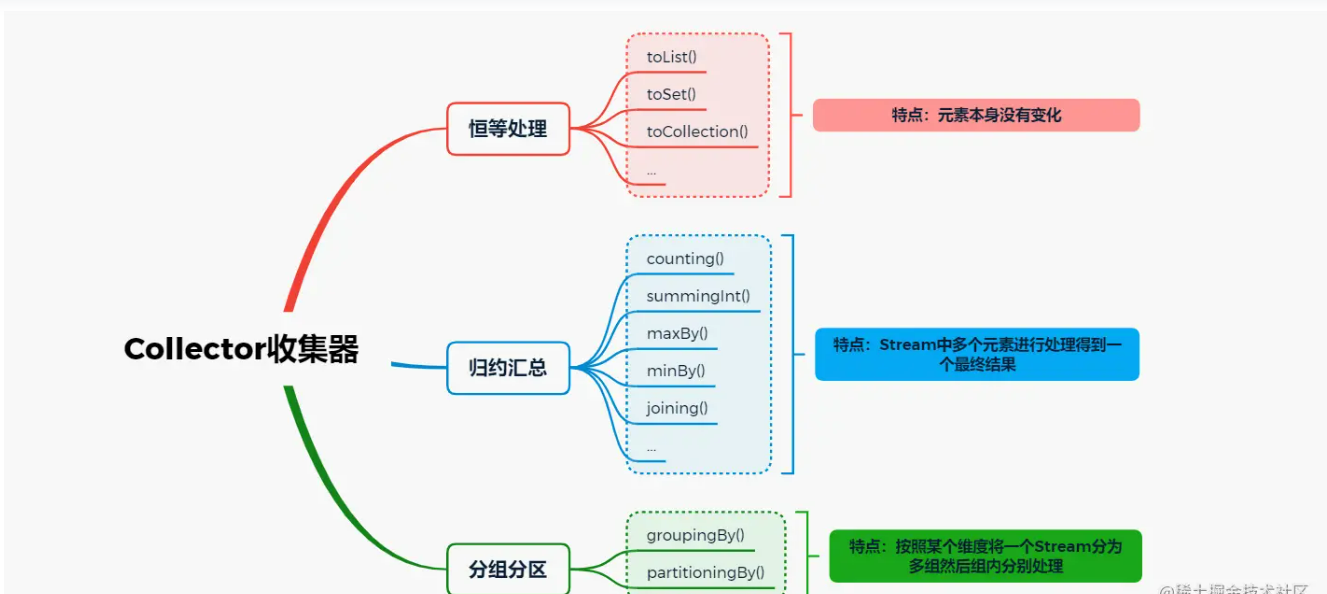
# 恒等处理Collector
所谓恒等处理,指的就是Stream的元素在经过Collector函数处理前后完全不变,例如toList()操作,只是最终将结果从Stream中取出放入到List对象中,并没有对元素本身做任何的更改处理:
list.stream().collect(Collectors.toList());
list.stream().collect(Collectors.toSet());
list.stream().collect(Collectors.toCollection());
# 归约汇总Collector
对于归约汇总类的操作,Stream流中的元素逐个遍历,进入到Collector处理函数中,然后会与上一个元素的处理结果进行合并处理,并得到一个新的结果,以此类推,直到遍历完成后,输出最终的结果。
public void calculateSum() {
Integer salarySum = getAllEmployees().stream()
.filter(employee -> "上海公司".equals(employee.getSubCompany()))
.collect(Collectors.summingInt(Employee::getSalary));
System.out.println(salarySum);
}
# 分组分区Collector
Collectors工具类中提供了groupingBy方法用来得到一个分组操作Collector
groupingBy()操作需要指定两个关键输入,即分组函数和值收集器:
分组函数:一个处理函数,用于基于指定的元素进行处理,返回一个用于分组的值(即分组结果HashMap的Key值),对于经过此函数处理后返回值相同的元素,将被分配到同一个组里。
值收集器:对于分组后的数据元素的进一步处理转换逻辑,此处还是一个常规的Collector收集器,和collect()方法中传入的收集器完全等同(可以想想俄罗斯套娃,一个概念)
# Collector的叠加嵌套
有的时候,我们需要根据先根据某个维度进行分组后,再根据第二维度进一步的分组,然后再对分组后的结果进一步的处理操作,这种场景里面,我们就可以通过Collector收集器的叠加嵌套使用来实现。
public void groupByCompanyAndDepartment() {
// 按照子公司+部门双层维度,统计各个部门内的人员数
Map<String, Map<String, Long>> resultMap = getAllEmployees().stream()
.collect(Collectors.groupingBy(Employee::getSubCompany,
Collectors.groupingBy(Employee::getDepartment,
Collectors.counting())));
System.out.println(resultMap);
}
# Collectors提供的收集器
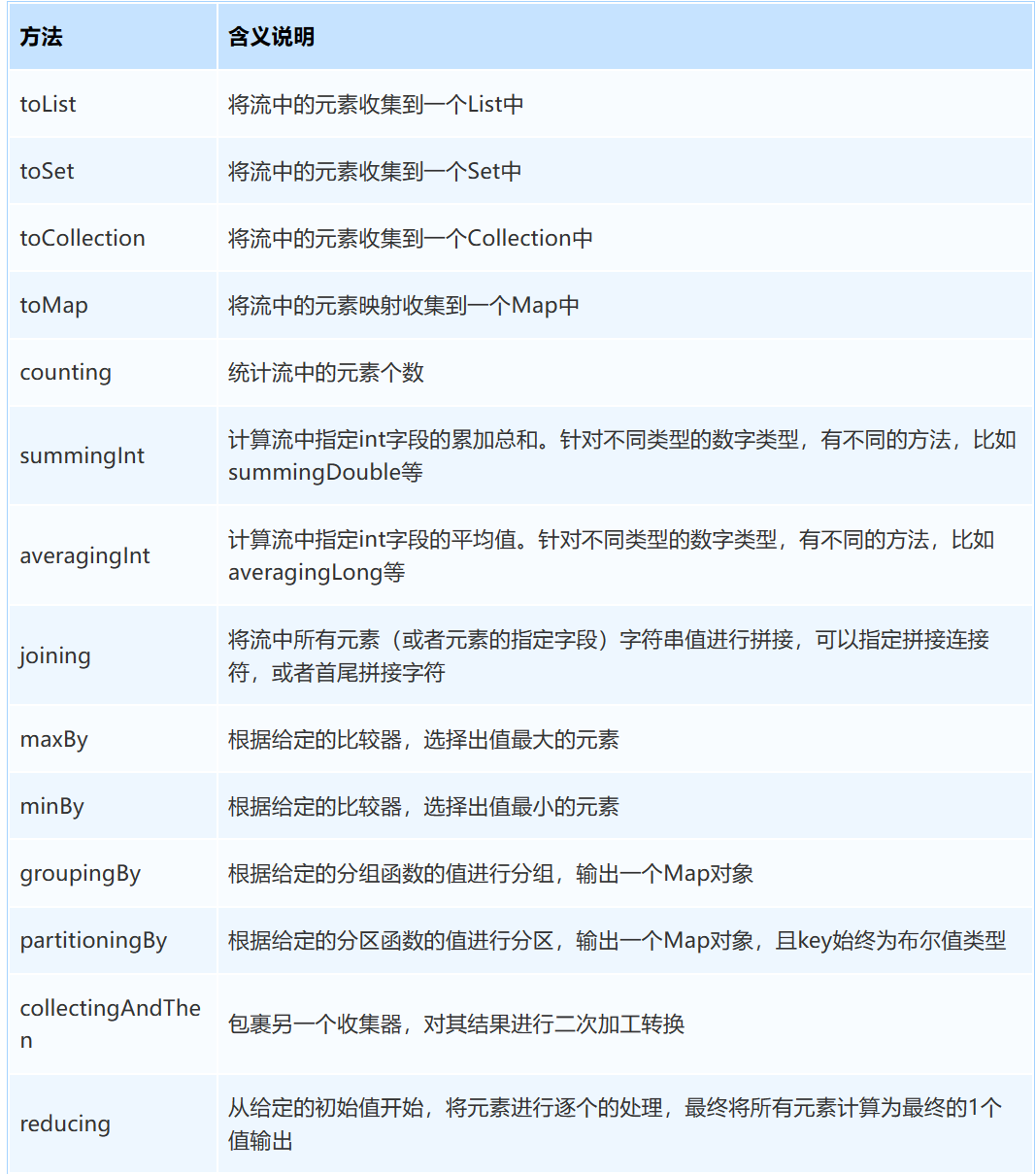
# Collector接口介绍
所谓的收集器,其实就是一个Collector接口的具体实现类。所以如果想要定制自己的收集器,首先要先了解Collector接口到底有哪些方法需要我们去实现,以及各个方法的作用与用途。
当我们新建一个MyCollector类并声明实现Collector接口的时候,会发现需要我们实现5个接口:
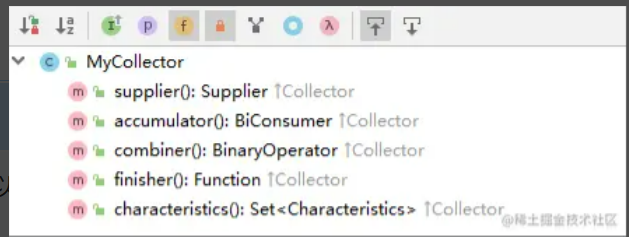
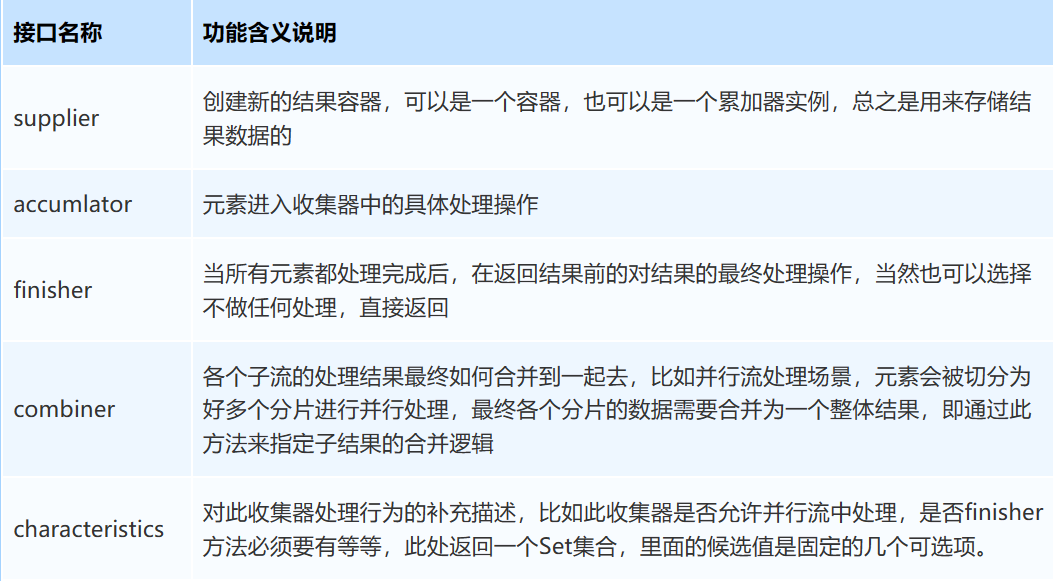 对于characteristics返回set集合中的可选值,说明如下:
对于characteristics返回set集合中的可选值,说明如下:

